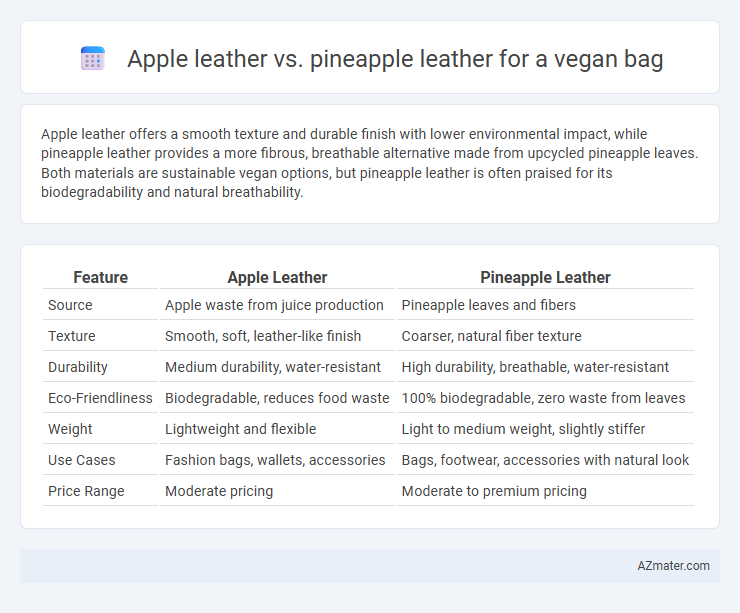Apple leather offers a smooth texture and durable finish with lower environmental impact, while pineapple leather provides a more fibrous, breathable alternative made from upcycled pineapple leaves. Both materials are sustainable vegan options, but pineapple leather is often praised for its biodegradability and natural breathability.
Table of Comparison
| Feature | Apple Leather | Pineapple Leather |
|---|---|---|
| Source | Apple waste from juice production | Pineapple leaves and fibers |
| Texture | Smooth, soft, leather-like finish | Coarser, natural fiber texture |
| Durability | Medium durability, water-resistant | High durability, breathable, water-resistant |
| Eco-Friendliness | Biodegradable, reduces food waste | 100% biodegradable, zero waste from leaves |
| Weight | Lightweight and flexible | Light to medium weight, slightly stiffer |
| Use Cases | Fashion bags, wallets, accessories | Bags, footwear, accessories with natural look |
| Price Range | Moderate pricing | Moderate to premium pricing |
Introduction to Vegan Leathers
Vegan leathers like Apple leather and Pineapple leather offer sustainable alternatives to traditional animal leather, catering to eco-conscious consumers. Apple leather is made from apple waste, providing a durable, cruelty-free material with a soft texture and excellent breathability. Pineapple leather, derived from pineapple leaves, boasts high strength and flexibility, making it a popular choice for vegan bags that combine environmental responsibility with stylish design.
What is Apple Leather?
Apple leather is an innovative vegan material made from the processed waste of apple peels and cores, offering a sustainable alternative to traditional leather. It features a soft, durable texture with natural breathability, making it ideal for eco-friendly bags that require both style and functionality. Apple leather's minimal environmental impact, including reduced water usage and lower carbon emissions, distinguishes it from other plant-based leathers like pineapple leather.
What is Pineapple Leather?
Pineapple leather, also known as Pinatex, is an innovative, sustainable material made from the cellulose fibers of pineapple leaves. This vegan leather alternative offers durability, breathability, and a unique texture, making it ideal for eco-friendly bags. Compared to apple leather, pineapple leather is highly renewable, utilizing agricultural waste while reducing environmental impact.
Sustainability Comparison
Apple leather and pineapple leather both offer sustainable alternatives to traditional animal leather, but they differ in environmental impact and resource use. Apple leather is produced from apple waste, reducing food industry byproducts and lowering carbon emissions, while pineapple leather, made from pineapple leaf fibers, utilizes agricultural waste without requiring additional water or pesticides. Pineapple leather generally has a smaller water footprint and faster biodegradability, making it a highly eco-friendly option for vegan bags focused on sustainability.
Durability and Longevity
Apple leather offers moderate durability with a smooth texture, making it suitable for stylish vegan bags that withstand daily wear but may show signs of aging over time. Pineapple leather, often known as Pinatex, provides higher durability due to its fibrous structure, resulting in greater resistance to abrasion and longer-lasting longevity in vegan bags. Both materials are sustainable alternatives to traditional leather, with pineapple leather typically outperforming apple leather in durability metrics.
Texture and Aesthetic Appeal
Apple leather offers a smooth, supple texture with a subtle grain pattern that closely mimics traditional leather, providing a sleek and polished aesthetic ideal for high-end vegan bags. Pineapple leather, derived from Pinatex, features a coarser, fibrous texture with a natural matte finish, lending bags a unique, eco-friendly look that highlights sustainable fashion. Both materials showcase durability and cruelty-free qualities, but apple leather appeals to those seeking refined elegance while pineapple leather attracts consumers valuing bold, organic design elements.
Production Process Differences
Apple leather is produced by combining apple peels and cores, which are waste from the juice industry, with polyurethane or other binders to create a flexible, durable material through mechanical shredding and pressing. In contrast, pineapple leather, often known as Pinatex, utilizes pineapple leaf fibers that undergo a decortication process to extract long cellulose fibers, which are then felted and combined with a non-woven fabric base before coating for leather-like qualities. The distinct raw material sources and fiber extraction methods lead to variations in texture, sustainability profiles, and production scalability for vegan bag manufacturing.
Cost and Accessibility
Apple leather typically costs more than pineapple leather due to its complex production process involving the use of apple waste and synthetic binders. Pineapple leather, derived from pineapple leaf fibers, is generally more accessible and affordable as it utilizes agricultural byproducts readily available in tropical regions. Both materials offer sustainable vegan alternatives, but pineapple leather provides a cost-effective option with wider availability for eco-friendly bag production.
Environmental Impact
Apple leather utilizes apple waste from juice production, reducing landfill waste and minimizing water and chemical use, making it an eco-friendly alternative to traditional leather. Pineapple leather, derived from pineapple leaf fibers, employs agricultural byproducts that would otherwise be discarded, promoting sustainability through renewable, biodegradable materials. Both options significantly lower carbon footprints compared to animal leather, with pineapple leather typically requiring less water in processing.
Which Vegan Leather is Best for Bags?
Apple leather offers durability and a smooth texture with a slightly glossy finish, making it ideal for high-quality vegan bags that require flexibility and resistance to wear. Pineapple leather, known as Pinatex, provides a unique, breathable texture and environmental sustainability due to its use of pineapple leaf fibers, appealing to eco-conscious consumers. The best vegan leather for bags depends on whether durability and finish (apple leather) or sustainability and texture (pineapple leather) are prioritized by the user.

Infographic: Apple leather vs Pineapple leather for Vegan bag
 azmater.com
azmater.com